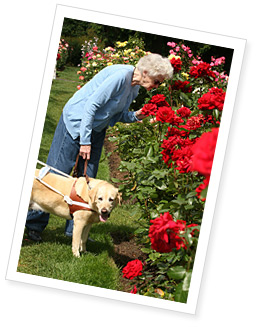Text Size:


Mariella Dibble and Silky
By Mariella Dibble

Mariella Dibble got her first Guide Dog from Guide Dogs for the Blind when she was 62. Now at 88, she’s on her third and is still on the go. "They keep me busy – I get my exercise! And they make me happy! Especially this one," she said, affectionately patting her Guide Dog, Silky, "This one is wonderful. I'm hardly out of bed in the morning and she has done something to put a smile on my face."
A birth defect dramatically reduced Mariella's vision. She's been legally blind since 1960, but she can see some shapes and colors, mostly with her peripheral vision. "For years I didn't think I would be able to get a Guide Dog since I have some vision." She was thrilled to find out she was wrong.
Most people who are legally blind have some vision. Tunnel vision (or loss of peripheral vision) can have a major impact on a person’s ability to see steps and curbs. Other types of vision loss can also affect safety.
"I felt like it would be very beneficial to me to have a Guide Dog,” Mariella said. “I can see some things but if it's in my blind spot I can walk right into a wall. Having a dog helps. I have her eyes to help me negotiate the world safely and I don’t have to rely just on my own."
The challenge for people with low vision is to put their trust in the dog, rather than their remaining vision. A dog that is encouraged to take frequent shortcuts may lose its training as a mobility guide.
There is no upper age limit to apply for a Guide Dog and Mariella was physically active, mobile and able to withstand the rigors of training. During her home interview, she demonstrated her ability to travel independently on several routes in her home area with her cane. And she had the physical stamina to be able to control and care for a dog.
Sprout was her first Guide Dog, a beautiful female Golden Retriever. Sprout worked for eight years and then retired as Mariella's pet for two more years. "When I would take her out to the back yard to brush her, sometimes I would get a flash of sunlight off of her golden hair. She was beautiful." Her next Guide Dog was Chicory, another Golden who worked with her for nine years and then retired with the family as a pet.
These days it is, Silky, a friendly yellow Labrador, that accompanies Mariella to a support group where she assists people who are newly blind. "One thing I tell people who are considering a Guide Dog is there are some responsibilities,” she said. “You have to keep them groomed, and you can't just go off and leave them. At times I've had to change my plans to accommodate the dog. On the other hand, Guide Dogs are real social ice breakers. When you travel with a cane, many people just don't know how to relate to you. But people love to talk to you about your dog."
Now, instead of worrying about every crack and step, Mariella and Silky can take some time to fully enjoy life and just smell the roses.
Leave your comment
You must be an icarevillage member to comment on this article.
Join today
to take advantage of this service or
Sign In
if you are already a member.